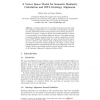126 search results - page 3 / 26 » From Frequency to Meaning: Vector Space Models of Semantics |
ENTCS
2011
13 years 3 months ago
2011
We use Bell states to provide compositional distributed meaning for negative sentences of English. The lexical meaning of each word of the sentence is a context vector obtained wi...
ACL
2003
13 years 9 months ago
2003
Traditional vector-based models use word co-occurrence counts from large corpora to represent lexical meaning. In this paper we present a novel approach for constructing semantic ...
NLDB
2007
Springer
14 years 2 months ago
2007
Springer
Abstract. In this paper, we target document ranking in a highly technical field with the aim to approximate a ranking that is obtained through an existing ontology (knowledge stru...
NAACL
2003
13 years 9 months ago
2003
e by placing terms in an abstract ‘information space’ based on their occurrences in text corpora, and then allowing a user to visualize local regions of this information space....
DEXA
2006
Springer
14 years 2 days ago
2006
Springer
Ontology alignment (or matching) is the operation that takes two ontologies and produces a set of semantic correspondences (usually semantic similarities) between some elements of ...

